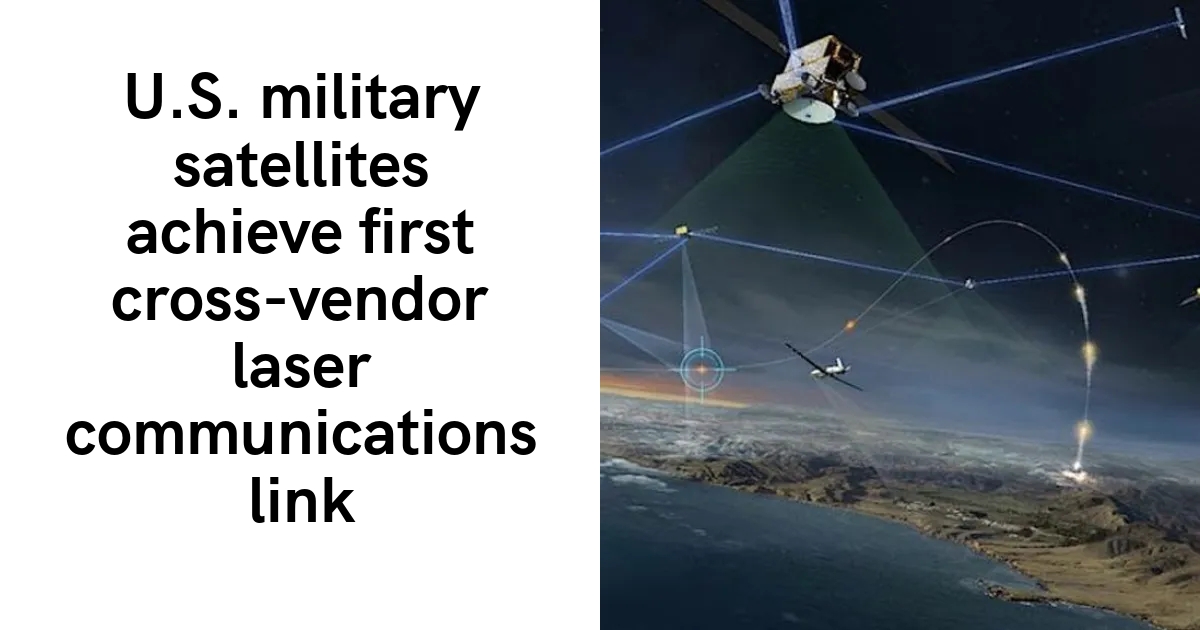Landmark Achievement in Satellite Communication: A Closer Look at the U.S. Military’s New Network
In a significant development in satellite communications, U.S. military satellites crafted by York Space Systems and SpaceX have successfully demonstrated an interoperable laser communication link in low Earth orbit. This achievement marks an important milestone for the Pentagon’s cutting-edge satellite network, aimed at transforming military communications and missile tracking capabilities.
Understanding the Proliferated Warfighter Space Architecture
The satellites involved are part of the U.S. Space Force’s ambitious Proliferated Warfighter Space Architecture (PWSA). This network is designed to bolster military communication systems and enhance missile tracking proficiency. The recent demonstration engaged satellites from Tranche 0, the initial phase of the PWSA, which consists of 27 satellites operating at an altitude of about 1,000 kilometers. This phase signals a strategic shift from the military’s traditional dependency on a few large satellites to a more distributed network of smaller, more agile spacecraft.
Denver-based York Space Systems announced on January 9 that one of its Tranche 0 Transport satellites successfully transmitted data to a Tranche 0 Tracking satellite developed by SpaceX. This was accomplished using laser communication terminals, with York’s satellite utilizing a terminal provided by Tesat-Spacecom and SpaceX employing its internally developed terminal.
"This demonstration realizes another important step in the Space Development Agency’s (SDA) achieving its vision of an extensible and proliferated constellation built by multiple vendors to a common interface standard," stated York CEO Dirk Wallinger.
The Role of the Space Development Agency
The Space Development Agency (SDA), which manages this program, has mandated a standardized Optical Communication Terminal protocol. This ensures seamless data exchange between satellites from various manufacturers. Laser communications offer several advantages over traditional radio frequency methods, including faster data transmission and enhanced security.
Expansion and Future Prospects
With the successful test behind them, the Pentagon is preparing to expand the network significantly. Tranche 1, scheduled to begin launching this year, will add approximately 150 satellites to the constellation. The SDA emphasizes that a proliferated constellation enhances the resilience of military space assets against potential threats by dispersing capabilities across a broader network.
The Tranche 0 program has awarded contracts to multiple vendors, including York Space Systems, SpaceX, Lockheed Martin, and L3Harris Technologies. This approach maintains competitive diversity within the industrial base, ensuring that no single entity dominates the technological landscape.
Implications for Global Military Communications
The successful implementation of cross-vendor laser communications in low Earth orbit represents a substantial leap forward in satellite technology. This capability is expected to revolutionize military communication systems, offering more robust and flexible options for data transmission. The shift towards a distributed network of smaller satellites not only enhances security and resilience but also paves the way for more advanced and efficient satellite networks.
Good to Know: The Technical Edge of Laser Communications
Laser communication, also known as optical communication, uses light to transmit information. In the context of satellites, this means data can be transferred at much higher speeds than traditional radio waves, with increased security and less susceptibility to interference. For layman understanding, imagine replacing a slow public Wi-Fi connection with a fast, secure fiber-optic cable—this is akin to the leap from radio to laser communications in space.
Expert Opinions and Industry Reactions
Experts in the field of satellite communications have lauded this achievement as a game-changer for military satellite networks. The ability to integrate different systems from various vendors without compromising on performance or security is seen as a critical step forward.
Industry analysts suggest that this development could have significant implications beyond military applications. The technologies and standards developed for PWSA could potentially influence commercial satellite networks, leading to enhanced global connectivity and data services.
Conclusion: A New Era in Satellite Communications
The successful demonstration of cross-vendor laser communications marks a pivotal moment in the evolution of military satellite networks. As the U.S. Space Force continues to expand and enhance its Proliferated Warfighter Space Architecture, the benefits of this technology will likely extend far beyond military applications, potentially reshaping global communication infrastructures.
This achievement underscores the importance of innovation and collaboration in advancing satellite technology. With the continued support and development of these cutting-edge systems, the future of satellite communications looks promising, offering faster, more secure, and more resilient networks for a wide range of applications.
For more detailed information on this development, you may refer to the original article on spacenews.com.
For more Information, Refer to this article.


































